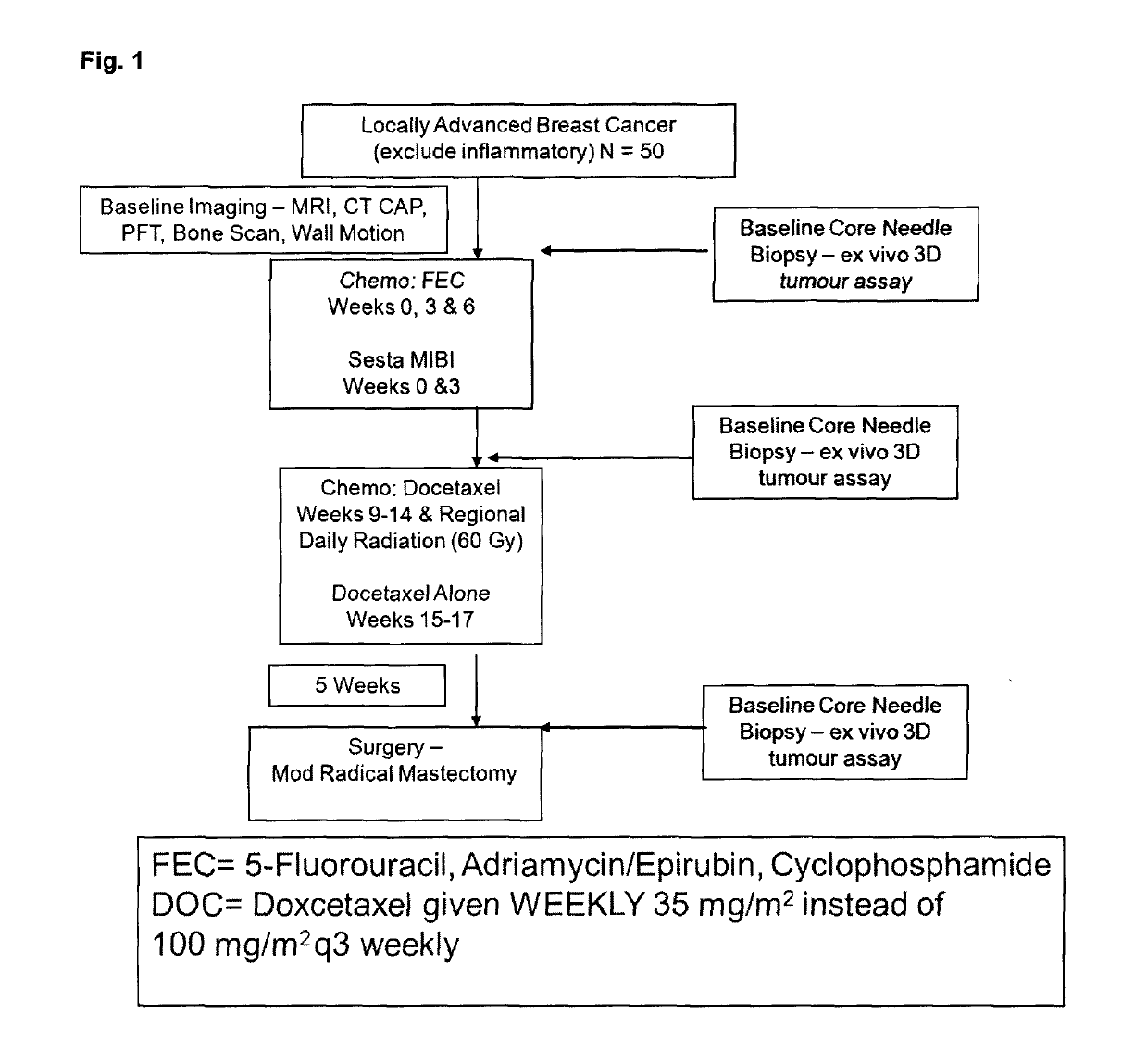Methods and kits for monitoring response to radiation therapies in cancer
a radiation therapy and kit technology, applied in the field of breast and ovarian cancer, to achieve the effect of accurately capturing cytotoxic substances
- Summary
- Abstract
- Description
- Claims
- Application Information
AI Technical Summary
Benefits of technology
Problems solved by technology
Method used
Image
Examples
example 1
Incidence, Mortality, and Treatment of Breast Cancer
[0305]Breast cancer is the most common cancer diagnosis in women, with 22,300 and 5,300 Canadian women being diagnosed with and dying of the disease in 2007, respectively1. Although treatments have improved both survival and progression-free survival for early and metastatic breast cancer patients, those with locally advanced breast cancer (LABC) have significantly poorer treatment outcome. LABC is traditionally defined as stage IIB (T3N0) and Stage IIIA / B from the TMN classification. Clinically these tumours are greater than 5 cm in size and / or extend beyond the breast tissue into the surrounding skin or muscle, with / without matted axillary lymph nodes (N2), internal mammary nodes (N3) or ipsilateral supraclavicular lymph node involvement. LABC represents approximately 10-15% of all breast cancer cases, and the survival is estimated at 30-42% at 5 years1 a significant portion of whom will be living with metastatic disease. However...
example 2
Changes in Tumour Cell RNA Integrity In Vitro in Response to Radiation With or Without Docetaxel Treatment
[0324]There are genomic similarities between ovarian and breast cancers (Nature 490:67-70, 4 Oct., 2012) and may show similar responses. To this end, we looked at an ovarian cancer line for its RNA response to radiation therapy.
[0325]Experiments were conducted to assess whether radiation with or without docetaxel treatment could induce changes in cellular RNA concentration and / or RIN values in A2780 ovarian tumour cells. As shown in FIG. 5A, radiation treatment induced a dose-dependent change in A2780 cell RNA content, with 10 Gray of radiation inducing almost a 5-fold reduction in RNA concentration levels. Interestingly, pre-incubation of cells with 0.1 μM docetaxel further reduced cellular RNA concentration by an additional 6.5-fold, almost eliminating all RNA from the cells. In contrast under the tested conditions, radiation doses up to 5 Gray had no effect on cellular RNA in...
example 3
[0330]A2780 cells were treated with increasing doses of Epirubicin with and without 10 Gy radiation.A2780 cells were plated into 6 cm plates in 4 ml of RPMI culture medium. The plates were placed in the incubator and the cells were allowed to adhere overnight. The next day, the medium was removed from all plates and new media containing the appropriate epirubicin concentration (1 pM, 5 pM, 20 nM, 50 nM, and 100 nM) was added to the plates. Cells were pre-treated for 24 h with epirubicin prior to receiving radiation treatment. The following day (24 h post epirubicin drug-treatment), the cells were given 10 Gy of x-ray radiation treatment (300 kV, 9 mA) in approximately 4.3 min of x-ray exposure using a RS320 Irradiation System (Gulmay Medical) The cells were returned to the cell culture incubator, and RNA was extracted from the cells 96 h post-radiation treatment (which corresponds to 120 h post-epirubicin treatment).
[0331]FIG. 8A shows RIN values versus Epirubicin dose. A loss in RI...
PUM
| Property | Measurement | Unit |
|---|---|---|
| concentration | aaaaa | aaaaa |
| concentration | aaaaa | aaaaa |
| concentration | aaaaa | aaaaa |
Abstract
Description
Claims
Application Information
 Login to View More
Login to View More - R&D
- Intellectual Property
- Life Sciences
- Materials
- Tech Scout
- Unparalleled Data Quality
- Higher Quality Content
- 60% Fewer Hallucinations
Browse by: Latest US Patents, China's latest patents, Technical Efficacy Thesaurus, Application Domain, Technology Topic, Popular Technical Reports.
© 2025 PatSnap. All rights reserved.Legal|Privacy policy|Modern Slavery Act Transparency Statement|Sitemap|About US| Contact US: help@patsnap.com



